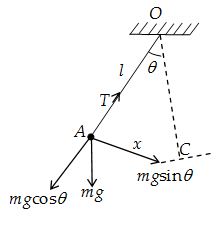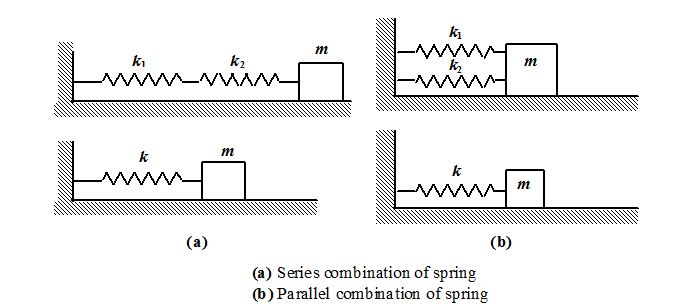Video Lecture
Theory For Notes Making
Derivation of expression for period of a Simple Pendulum

The particle in a simple pendulum moves in an arc of a circle of radius l = OA (See figure). The forces acting on the particle are its weight mg and the tension T along the string. The tangential component of the resultant force, from the figure, is
FT = – mg sin θ …(i)
where the minus sign appears because its direction is opposite to the displacement x = CA. The equation for the tangential motion is
Since the particle moves along a circle of radius l, we may use Equations, aT= \displaystyle {{a}_{T}}=R\frac{{{{d}^{2}}\theta }}{{d{{t}^{2}}}}, with R replaced by l, to express the tangential acceleration. That is,
\displaystyle {{a}_{T}}=l\frac{{{{d}^{2}}\theta }}{{d{{t}^{2}}}}
Thus, the equation for the tangential motion, from equation (i) is
\displaystyle ml\frac{{{{d}^{2}}\theta }}{{d{{t}^{2}}}}=-mg\sin \theta
or \displaystyle \frac{{{{d}^{2}}\theta }}{{d{{t}^{2}}}}+\frac{g}{l}\sin \theta =0 ….(ii)
This equation is not in the standard form because of the presence of sin θ instead of just θ. However, if the angle θ is small, which is true in case the amplitude of the oscillations is very small, we may use the series expansion of sin θ \displaystyle \left( {\sin \theta =\theta -\frac{{{{\theta }^{3}}}}{{3!}}+……} \right) and keep only the first term. So we write \displaystyle \sin \theta \simeq \theta in equation for the motion of the pendulum, which becomes
\displaystyle \frac{{{{d}^{2}}\theta }}{{d{{t}^{2}}}}+\frac{g}{l}\theta =0
This equation is identical to standard equation, \displaystyle \frac{{{{d}^{2}}\theta }}{{d{{t}^{2}}}}+{{\omega }^{2}}\theta =0. Thus we may conclude that, within our approximation, the angular motion of the pendulum is simple harmonic, with
\displaystyle {{\omega }^{2}}=\frac{g}{l}
The angle θ can thus be expressed in the form
\displaystyle \theta ={{\theta }_{0}}\sin \ (\omega t\pm \phi ) where \displaystyle {{\theta }_{0}}is called angular amplitude.
Using Equation, T = 2p/w, we can express the period of oscillation of the pendulum as
\displaystyle T=2\pi \sqrt{{\frac{l}{g}}}
For large amplitudes the approximation \displaystyle \sin \theta \simeq \theta is not valid and the calculation of the period is more complex.
It is relatively easy and instructive to obtain a better approximation for T. Again using the series expansion of sin q, keeping only the first two terms, we may write
\displaystyle \sin \theta =\theta -\frac{{{{\theta }^{3}}}}{{3!}}+….\approx \theta \left( {1-\frac{{{{\theta }^{2}}}}{6}} \right)
which when inserted in equation (ii) gives a second-order approximation to the equation of motion,
\displaystyle \frac{{{{d}^{2}}\theta }}{{d{{t}^{2}}}}+\frac{g}{l}\left( {1-\frac{{{{\theta }^{2}}}}{6}} \right)\theta =0
We may make another approximation by replacing q2 in the parentheses by \displaystyle {{({{\theta }^{2}})}_{{av}}}=\tfrac{1}{2}\theta _{0}^{2}. Then
\displaystyle \frac{{{{d}^{2}}\theta }}{{d{{t}^{2}}}}+\frac{g}{l}\left( {1-\frac{{\theta _{0}^{2}}}{{12}}} \right)\theta =0
which again is an equation of type \displaystyle \frac{{{{d}^{2}}\theta }}{{d{{t}^{2}}}}\,+\,{{\omega }^{2}}\theta =0. Therefore, up to this order of approximation
\displaystyle {{\omega }^{2}}=\frac{g}{l}\left( {1-\frac{{\theta _{0}^{2}}}{{12}}} \right)
Then \displaystyle T’=\frac{{2\pi }}{\omega }=2\pi \sqrt{{\frac{l}{g}}}{{\left( {1-\frac{{\theta _{0}^{2}}}{{12}}} \right)}^{{-1/2}}}
\displaystyle \approx \ 2\pi \sqrt{{\frac{l}{g}}}\ \left( {1+\frac{{\theta _{0}^{2}}}{{24}}} \right)
A more precise approximation gives
\displaystyle T=2\pi \sqrt{{\frac{l}{g}}}\left( {1+\frac{{\theta _{0}^{2}}}{{16}}+….} \right)
where the amplitude q0 must be expressed in radians. This is a sufficient approximation for most practical situations. In fact, the corrective term \displaystyle \theta _{0}^{2}/16 amounts to less than 1% for amplitudes less than 23° or 0.40 radians.
Important Points about Pendulum :
1.
The time period is independent of the mass of the bob. Therefore, if the solid bob is replaced by a hollow sphere of the same radius but different mass, the time period remains the same. Similarly, if a girl is swinging in a swing and another girl sits with her then there is no change in time period.
2.
The time period of a simple pendulum is independent of the amplitude of motion provided the motion is simple harmonic.
3.
The graph between T and l will be a parabola while the graph between \displaystyle {{T}^{2}}and l will be a straight line.
4.
If the length of simple pendulum is comparable to the radius of the earth (Re), then
\displaystyle T=2\pi \sqrt{{\left[ {\frac{{{{R}_{e}}}}{{g(1+{{R}_{e}}/l)}}} \right]}}
We consider the following two cases :
(i) When ,l = Re, then
\displaystyle T=2\pi \sqrt{{\left( {\frac{{\operatorname{Re}}}{{2g}}} \right)}}=2\pi \sqrt{{\left[ {\frac{{(6.4\times {{{10}}^{6}})}}{{2\times 9.8}}} \right]}}= 60 min
(ii) When \displaystyle l\to \infty \ i.e.,\ l>>{{R}_{e}}, then
\displaystyle T=2\pi \sqrt{{\left( {\frac{{{{R}_{e}}}}{g}} \right)}}=2\pi \sqrt{{\left[ {\frac{{(6.4\times {{{10}}^{6}})}}{{9.8}}} \right]}}= 84.63 min.
5.
If the thread of the simple pendulum is replaced by a wire then due to change in temperature its length will increase. Therefore, the time period will increase.
Now, \displaystyle l={{l}_{0}}(1+\alpha \Delta \theta )
Where Δθ is the change in temperature and a is the coefficient of linear expansion of the wire.
\displaystyle T=2\pi \sqrt{{\left( {\frac{1}{g}} \right)}}\ \ \ \text{and}\ \ {{T}_{0}}=2\pi \sqrt{{\left( {\frac{{{{l}_{0}}}}{g}} \right)}}
\displaystyle \frac{T}{{{{T}_{0}}}}=\sqrt{{\left( {\frac{l}{{{{l}_{0}}}}} \right)}}={{(1+\alpha \Delta \theta )}^{{1/2}}}=\left( {1+\frac{1}{2}\propto \Delta \theta } \right)
\displaystyle \frac{T}{{{{T}_{0}}}}-1=\frac{1}{2}\alpha \Delta \theta \ \ \text{or}\ \ \frac{{\Delta T}}{{{{T}_{0}}}}=\frac{1}{2}\alpha \Delta \theta
6.
If bob of a simple pendulum is made to oscillate in a fluid of density r0 (r0<r) where r is the density of the material of the bob, then the time period of simple pendulum will increase.
In this case, \displaystyle {g}’=g\left( {1-\frac{{{{\rho }_{0}}}}{\rho }} \right)because \displaystyle m{g}’=mg-\text{thrust}
\displaystyle \therefore \ \ \ \frac{{{T}’}}{T}=\sqrt{{\left( {\frac{g}{{{g}’}}} \right)}}=\sqrt{{\left[ {\frac{1}{{(1-{{\rho }_{0}}/\rho )}}} \right]}}=\sqrt{{\left( {\frac{\rho }{{\rho -{{\rho }_{0}}}}} \right)}}
Period of oscillation of a vertical spring-mass system

Let xobe the deformation in the spring in equilibrium.
Then kxo= mg
When the block is further displaced by x, the net restoring force is given by
F = -[k(x + xo) – mg]
or F = –kx(because kxo= mg)
Using second law of motion,
m\frac{{{{d}^{2}}x}}{{d{{t}^{2}}}}=-kx
or \frac{{{{d}^{2}}x}}{{d{{t}^{2}}}}+\left( {\frac{k}{m}} \right)x=0
Thus, w2 = \frac{k}{m} or T = 2π \sqrt{{\frac{m}{k}}}
Note that gravity does not influence the time period of the spring-mass system, it merely changes the equilibrium position.
Alternate method:
Total energy of the system at any instant is given by
\displaystyle E=\frac{1}{2}m{{V}^{2}}+\frac{1}{2}K{{x}^{2}}
on differentiating the equation with respect to time we get
\displaystyle \frac{{dE}}{{dt}}=\frac{1}{2}m2V\frac{{dV}}{{dt}}+\frac{1}{2}K.2x\frac{{dx}}{{dt}}=0
\displaystyle \frac{{dV}}{{dt}}=-\frac{K}{m}x
\displaystyle \frac{{{{d}^{2}}x}}{{d{{t}^{2}}}}+\frac{K}{m}x=0
Compare it with standard equation of simple harmonic motion
\displaystyle \frac{{{{d}^{2}}x}}{{d{{t}^{2}}}}+{{\omega }^{2}}x=0
\displaystyle \omega =\sqrt{{\frac{K}{m}}}
or \displaystyle T=2\pi \sqrt{{\frac{m}{K}}}
Series and Parallel Combinations of Springs

When two springs are joined in series, the equivalent stiffness of the combination is given by :
\frac{1}{k}=\frac{1}{{{{k}_{1}}}}+\frac{1}{{{{k}_{2}}}}
When two springs are joined in parallel, the equivalent stiffness of the combination is given by
k = k1 + k2
Illustration
If length of second pendulum is increased by 21%. Then how many oscillations decrease per day?
Solution
No. of oscillation made by second pendulum per day.
\displaystyle {{N}_{1}}=\frac{{24\times 60\times 60}}{2}
When length is increased by 21% then time period
\displaystyle \frac{{{{T}_{2}}}}{{{{T}_{1}}}}=\sqrt{{\frac{{1.21L}}{L}}}
\displaystyle {{T}_{2}}=2.2\sec
No of oscillation per day.
\displaystyle {{N}_{2}}=\frac{{24\times 60\times 60}}{{2.2}}
Difference of oscillation \displaystyle ={{N}_{1}}-{{N}_{2}}
\displaystyle =\frac{{24\times 60\times 60}}{2}-\frac{{24\times 60\times 60}}{{2.2}}
= 3927
Illustration
A 2 kg block is attached to a spring for which k = 200 N/m. It is held at an extension of 5 cm and then released at t = 0. Find
(a) the displacement as a function of time
(b) the velocity when x = +A/2;
(c) the acceleration when x = +A/2, where A is the amplitude.
Solution
(a) We need to find a, w, and f in equation. The amplitude is the maximum extension; that is,
A = 0.05 m
We know the angular frequency of the spring-mass system is given by
w = \sqrt{{\frac{k}{m}}}=10\,\,rad/s
To find f we note that at t = 0 we are given x = +A and v = 0.
Thus, from the equation of displacement and velocity, we get
x = A sin (w t + Φ)
A = A sin (0 + Φ)
v = w A cos (w t + Φ)
0 = 10 A cos (0 + Φ)
Since sin Φ = 1 and cos Φ = 0, it follows that fΦ= π/2 rad. Thus,
x = 0.05 sin \left( {10t+\frac{\pi }{2}} \right)\,m ……..(i)
(b) In order to find the velocity we have to find phase when x = A/2. Equation (i) yields
\frac{1}{2}=\sin \left( {10t+\frac{\pi }{2}} \right),
from which we get that (10 t + \frac{\pi }{2}) = \frac{\pi }{6} or \frac{{5\pi }}{6}
The velocity is given by
v = \frac{{dx}}{{dt}} = 0.5 cos \left( {10t+\frac{\pi }{2}} \right)
= 0.5 cos \frac{\pi }{6} or 0.5 cos \frac{{5\pi }}{6}
= +0.43 m/s or -0.43 m/s
At a given position, there are two velocities of equal magnitude but of opposite directions.
(c) The acceleration at x = A/2 may be found from the equation,
a = -\frac{k}{m}x=-{{\omega }^{2}}x = -(10 rad/s)2(0.05/2 m) = -2.5 m/s2
Objective Assignment
Q.1
A simple pendulum of frequency n is taken up to a certain height above the ground and then dropped along with its support so that it falls freely under gravity. The frequency of oscillations of the falling pendulum will
(a) remain equal to n
(b) become greater than n
(c) become less than n
(c) become zero
Ans. (d)
Q.2
A pendulum is suspended in a lift and its period of oscillation, when lift is stationary is T0 With what acceleration a must the lift be raised for the period of oscillation of the pendulum to be T0/2
(a) -3g (b) 4g (c) 6g (d) -4g
Ans. (a)
Q.3
A uniform spring has a certain mass suspended from it and its period for vertical oscillations is T1. The spring is now cut into two equal halves and the same mass is suspended from one of the halves. The period of vertical oscillations now is T2. The ratio T2/T1 is
(a) \displaystyle \frac{1}{2}
(b) \displaystyle \frac{1}{{\sqrt{2}}}
(c) 2
(d) \displaystyle \sqrt{2}
Ans. (b)
Q.4
A spring of force constant k is cut into two equal halves. The force constant of each half is
(a) \displaystyle \frac{k}{{\sqrt{2}}}
(b) \displaystyle \frac{k}{2}
(c) k
(d) 2k
Ans. (d)
Q.5
A hollow sphere is filled with water. It is hung by a long thread. As the water flows out of a hole at the bottom, the period of oscillation will:
(a) First increase and then decrease
(b) First decrease and then increase
(c) Go on increasing
(d) Go on decreasing
Ans. (a)
Q.6
The time period of a simple pendulum inside a stationary lift is x=-\frac{1}{2},y=\frac{1}{2}s. What will be the time period when the lift moves upwards with an acceleration \eta =\frac{{p({{r}^{2}}-{{x}^{2}})}}{{4vl}}?
(a) \eta
(b) v=at+\frac{b}{{t+c}}
(c) \displaystyle \overset{\to }{\mathop{A}}\,,\overset{\to }{\mathop{B}}\,\,\,\,and\,\,\,\,\overset{\to }{\mathop{C}}\,
(d) \overset{\to }{\mathop{A}}\,+\overset{\to }{\mathop{B}}\,=\overset{\to }{\mathop{C}}\,
Ans. (c)
Q.7
If the metal bob of a simple pendulum is replaced by a wooden bob, then its time period will
(a) increase
(b) decrease
(c) remain the same
(d) may increase or decrease
Ans. (c)
Q.8
In figures a and b, combinations of two springs of force constants k1 and k2 (where k1 = k2) are given. Then the ratio of their time periods is

(a) 2 : 1
(b) 1 : 2
(c) 1 : 1
(d) None
Ans. (b)
Q.9
Four massless springs whose force constants are 2k, 2k, k and 2k respectively are attached to a mass M kept on a frictionless plane (as shown in Fig.). If the mass M is displaced in the horizontal direction, then the frequency of the system:

(a) \displaystyle \frac{{3K}}{4}
(b) \displaystyle {{y}_{2}}=3\sin \left( {\omega t+\frac{\pi }{3}} \right)
(c) \displaystyle \frac{{2\pi }}{\lambda }\left( {{{L}_{2}}-{{L}_{1}}} \right)
(d) \displaystyle \frac{{2\pi }}{\lambda }\left( {{{n}_{1}}{{L}_{1}}-{{n}_{2}}{{L}_{2}}} \right)
Ans. (b)
Q.10
A mass is suspended separately by two springs of spring constants k1 and k2 in successive order. The time periods of oscillations in the two cases are T1 and T2 If the same mass be suspended by connecting the two springs in parallel, (as shown in figure) then the time period of oscillations is T. The correct relation is

(a) \displaystyle {{T}^{2}}\,=\,T_{1}^{2}\,+\,T_{2}^{2}
(b) \displaystyle {{T}^{{-2}}}\,=\,T_{1}^{{-2}}\,+\,T_{2}^{{-2}}
(c) \displaystyle {{T}^{{-1}}}\,=\,T_{1}^{{-1}}\,+\,T_{2}^{{-1}}
(d) \displaystyle T={{T}_{1}}+{{T}_{2}}
Ans. (b)
Q.11
If both spring constants K1 and K2 are increased to 4K1 and 4K2 respectively, what will be the new frequency, if f was the original frequency:
(a) f (b) 2 f (c) ½ f (d) 4 f
Ans. (b)
Subjective Assignment
Lorem ipsum dolor sit amet, consectetur adipiscing elit. Ut elit tellus, luctus nec ullamcorper mattis, pulvinar dapibus leo.
